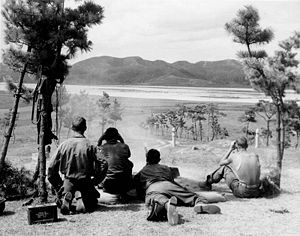| Battle of Taegu | |||||||
|---|---|---|---|---|---|---|---|
| Part of the Battle of Pusan Perimeter | |||||||
 U.S. 1st Cavalry Division soldiers fire at North Korean troops crossing the Naktong River | |||||||
| |||||||
| Belligerents | |||||||
|
|
| ||||||
| Commanders and leaders | |||||||
|
Douglas MacArthur Walton Walker |
Choi Yong-kun Kim Chaek | ||||||
| Strength | |||||||
| 4 divisions | 5 divisions | ||||||
| Casualties and losses | |||||||
|
200 killed 400 wounded | 3,700+ killed and wounded | ||||||
The Battle of Taegu was an engagement between United Nations Command (UN) and North Korean forces early in the Korean War, with fighting continuing from August 5–20, 1950 around the city of Taegu, South Korea. It was a part of the Battle of Pusan Perimeter, and was one of several large engagements fought simultaneously. The battle ended in a victory for the UN after their forces were able to drive off an offensive by Korean People's Army (KPA) divisions attempting to cross the Naktong River and assault the city.
Five KPA divisions massed around the city preparing to cross the Naktong River and assault it from the north and west. Defending the city were the US 1st Cavalry Division and Republic of Korea Army (ROK) II Corps. In a series of engagements, each of the KPA divisions attempted to cross the Naktong and attack the defending forces. The success of these attacks varied, with attacks in the 1st Cavalry Division sector repulsed while attacks in the ROK sector were more successful.
During the battle, KPA troops were able to surprise US troops on Hill 303 and capture them. Late in the battle, these US troops were machine gunned in the Hill 303 massacre. The UN forces were successful in driving most of the KPA off and the city was finally secured in the Battle of the Bowling Alley.